Ethical and Legal Implications of Facial Recognition and Algorithms
VerifiedAdded on 2022/10/09
|8
|2119
|42
Report
AI Summary
This report delves into the multifaceted ethical, social, and legal implications of facial recognition technology and algorithmic systems. It examines how these technologies, while offering advancements in security and crime prevention, pose significant challenges related to data privacy, civil liberties, and potential biases. The report highlights ethical dilemmas arising from the collection and use of personal data, including concerns about discrimination, surveillance, and the erosion of individual rights. It explores social issues such as the impact on freedom and cultural practices, and legal issues including the conversion of the world into a surveillance state and the potential for misuse of personal information. The report emphasizes the need for strong policies, data abstraction, and a balance between security and civil liberties, providing a comprehensive overview of the complex challenges and considerations surrounding the implementation of these technologies within the field of IT professional practice.

PROFESSIONAL PRACTICE IN IT
Paraphrase This Document
Need a fresh take? Get an instant paraphrase of this document with our AI Paraphraser

1
Contents
INTRODUCTION.................................................................................................................................1
Facial and Algorithm technologies........................................................................................................1
Ethical issues due to these two technologies..........................................................................................2
Social issues due to these two technologies...........................................................................................2
Legal issues due to the use of these two technologies...........................................................................3
Recommendation and conclusion..........................................................................................................4
References.............................................................................................................................................4
Contents
INTRODUCTION.................................................................................................................................1
Facial and Algorithm technologies........................................................................................................1
Ethical issues due to these two technologies..........................................................................................2
Social issues due to these two technologies...........................................................................................2
Legal issues due to the use of these two technologies...........................................................................3
Recommendation and conclusion..........................................................................................................4
References.............................................................................................................................................4
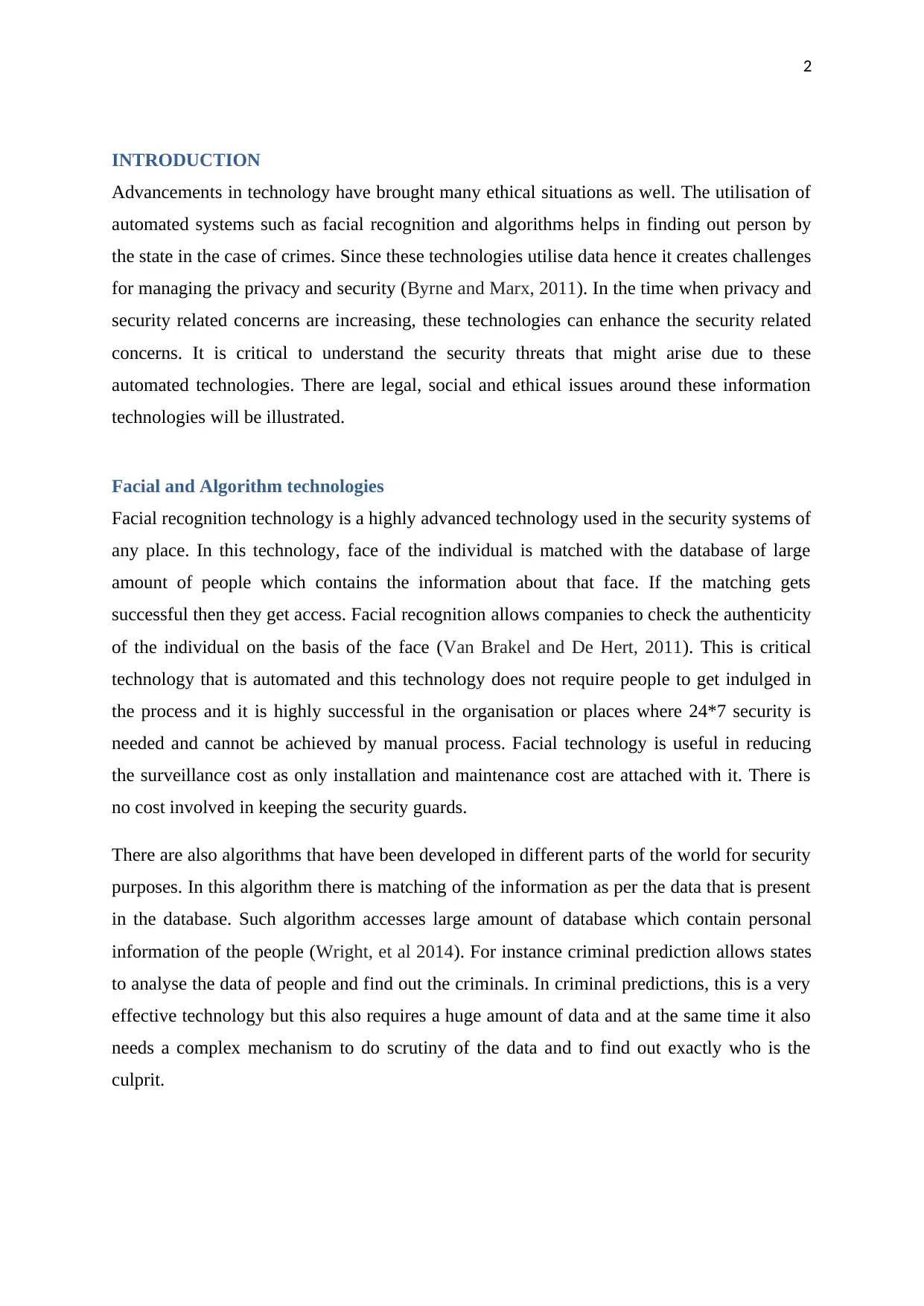
2
INTRODUCTION
Advancements in technology have brought many ethical situations as well. The utilisation of
automated systems such as facial recognition and algorithms helps in finding out person by
the state in the case of crimes. Since these technologies utilise data hence it creates challenges
for managing the privacy and security (Byrne and Marx, 2011). In the time when privacy and
security related concerns are increasing, these technologies can enhance the security related
concerns. It is critical to understand the security threats that might arise due to these
automated technologies. There are legal, social and ethical issues around these information
technologies will be illustrated.
Facial and Algorithm technologies
Facial recognition technology is a highly advanced technology used in the security systems of
any place. In this technology, face of the individual is matched with the database of large
amount of people which contains the information about that face. If the matching gets
successful then they get access. Facial recognition allows companies to check the authenticity
of the individual on the basis of the face (Van Brakel and De Hert, 2011). This is critical
technology that is automated and this technology does not require people to get indulged in
the process and it is highly successful in the organisation or places where 24*7 security is
needed and cannot be achieved by manual process. Facial technology is useful in reducing
the surveillance cost as only installation and maintenance cost are attached with it. There is
no cost involved in keeping the security guards.
There are also algorithms that have been developed in different parts of the world for security
purposes. In this algorithm there is matching of the information as per the data that is present
in the database. Such algorithm accesses large amount of database which contain personal
information of the people (Wright, et al 2014). For instance criminal prediction allows states
to analyse the data of people and find out the criminals. In criminal predictions, this is a very
effective technology but this also requires a huge amount of data and at the same time it also
needs a complex mechanism to do scrutiny of the data and to find out exactly who is the
culprit.
INTRODUCTION
Advancements in technology have brought many ethical situations as well. The utilisation of
automated systems such as facial recognition and algorithms helps in finding out person by
the state in the case of crimes. Since these technologies utilise data hence it creates challenges
for managing the privacy and security (Byrne and Marx, 2011). In the time when privacy and
security related concerns are increasing, these technologies can enhance the security related
concerns. It is critical to understand the security threats that might arise due to these
automated technologies. There are legal, social and ethical issues around these information
technologies will be illustrated.
Facial and Algorithm technologies
Facial recognition technology is a highly advanced technology used in the security systems of
any place. In this technology, face of the individual is matched with the database of large
amount of people which contains the information about that face. If the matching gets
successful then they get access. Facial recognition allows companies to check the authenticity
of the individual on the basis of the face (Van Brakel and De Hert, 2011). This is critical
technology that is automated and this technology does not require people to get indulged in
the process and it is highly successful in the organisation or places where 24*7 security is
needed and cannot be achieved by manual process. Facial technology is useful in reducing
the surveillance cost as only installation and maintenance cost are attached with it. There is
no cost involved in keeping the security guards.
There are also algorithms that have been developed in different parts of the world for security
purposes. In this algorithm there is matching of the information as per the data that is present
in the database. Such algorithm accesses large amount of database which contain personal
information of the people (Wright, et al 2014). For instance criminal prediction allows states
to analyse the data of people and find out the criminals. In criminal predictions, this is a very
effective technology but this also requires a huge amount of data and at the same time it also
needs a complex mechanism to do scrutiny of the data and to find out exactly who is the
culprit.
⊘ This is a preview!⊘
Do you want full access?
Subscribe today to unlock all pages.

Trusted by 1+ million students worldwide
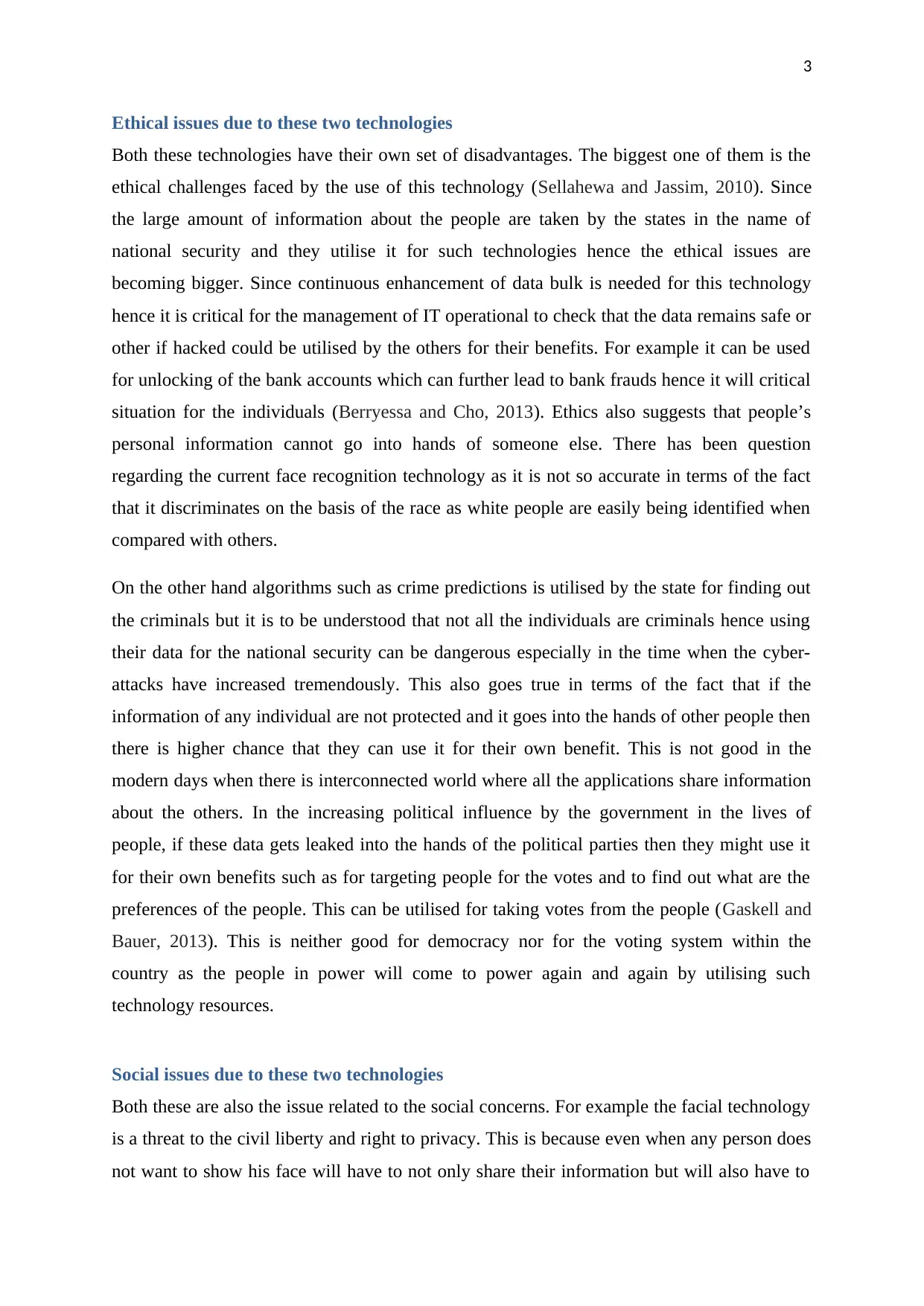
3
Ethical issues due to these two technologies
Both these technologies have their own set of disadvantages. The biggest one of them is the
ethical challenges faced by the use of this technology (Sellahewa and Jassim, 2010). Since
the large amount of information about the people are taken by the states in the name of
national security and they utilise it for such technologies hence the ethical issues are
becoming bigger. Since continuous enhancement of data bulk is needed for this technology
hence it is critical for the management of IT operational to check that the data remains safe or
other if hacked could be utilised by the others for their benefits. For example it can be used
for unlocking of the bank accounts which can further lead to bank frauds hence it will critical
situation for the individuals (Berryessa and Cho, 2013). Ethics also suggests that people’s
personal information cannot go into hands of someone else. There has been question
regarding the current face recognition technology as it is not so accurate in terms of the fact
that it discriminates on the basis of the race as white people are easily being identified when
compared with others.
On the other hand algorithms such as crime predictions is utilised by the state for finding out
the criminals but it is to be understood that not all the individuals are criminals hence using
their data for the national security can be dangerous especially in the time when the cyber-
attacks have increased tremendously. This also goes true in terms of the fact that if the
information of any individual are not protected and it goes into the hands of other people then
there is higher chance that they can use it for their own benefit. This is not good in the
modern days when there is interconnected world where all the applications share information
about the others. In the increasing political influence by the government in the lives of
people, if these data gets leaked into the hands of the political parties then they might use it
for their own benefits such as for targeting people for the votes and to find out what are the
preferences of the people. This can be utilised for taking votes from the people (Gaskell and
Bauer, 2013). This is neither good for democracy nor for the voting system within the
country as the people in power will come to power again and again by utilising such
technology resources.
Social issues due to these two technologies
Both these are also the issue related to the social concerns. For example the facial technology
is a threat to the civil liberty and right to privacy. This is because even when any person does
not want to show his face will have to not only share their information but will also have to
Ethical issues due to these two technologies
Both these technologies have their own set of disadvantages. The biggest one of them is the
ethical challenges faced by the use of this technology (Sellahewa and Jassim, 2010). Since
the large amount of information about the people are taken by the states in the name of
national security and they utilise it for such technologies hence the ethical issues are
becoming bigger. Since continuous enhancement of data bulk is needed for this technology
hence it is critical for the management of IT operational to check that the data remains safe or
other if hacked could be utilised by the others for their benefits. For example it can be used
for unlocking of the bank accounts which can further lead to bank frauds hence it will critical
situation for the individuals (Berryessa and Cho, 2013). Ethics also suggests that people’s
personal information cannot go into hands of someone else. There has been question
regarding the current face recognition technology as it is not so accurate in terms of the fact
that it discriminates on the basis of the race as white people are easily being identified when
compared with others.
On the other hand algorithms such as crime predictions is utilised by the state for finding out
the criminals but it is to be understood that not all the individuals are criminals hence using
their data for the national security can be dangerous especially in the time when the cyber-
attacks have increased tremendously. This also goes true in terms of the fact that if the
information of any individual are not protected and it goes into the hands of other people then
there is higher chance that they can use it for their own benefit. This is not good in the
modern days when there is interconnected world where all the applications share information
about the others. In the increasing political influence by the government in the lives of
people, if these data gets leaked into the hands of the political parties then they might use it
for their own benefits such as for targeting people for the votes and to find out what are the
preferences of the people. This can be utilised for taking votes from the people (Gaskell and
Bauer, 2013). This is neither good for democracy nor for the voting system within the
country as the people in power will come to power again and again by utilising such
technology resources.
Social issues due to these two technologies
Both these are also the issue related to the social concerns. For example the facial technology
is a threat to the civil liberty and right to privacy. This is because even when any person does
not want to show his face will have to not only share their information but will also have to
Paraphrase This Document
Need a fresh take? Get an instant paraphrase of this document with our AI Paraphraser
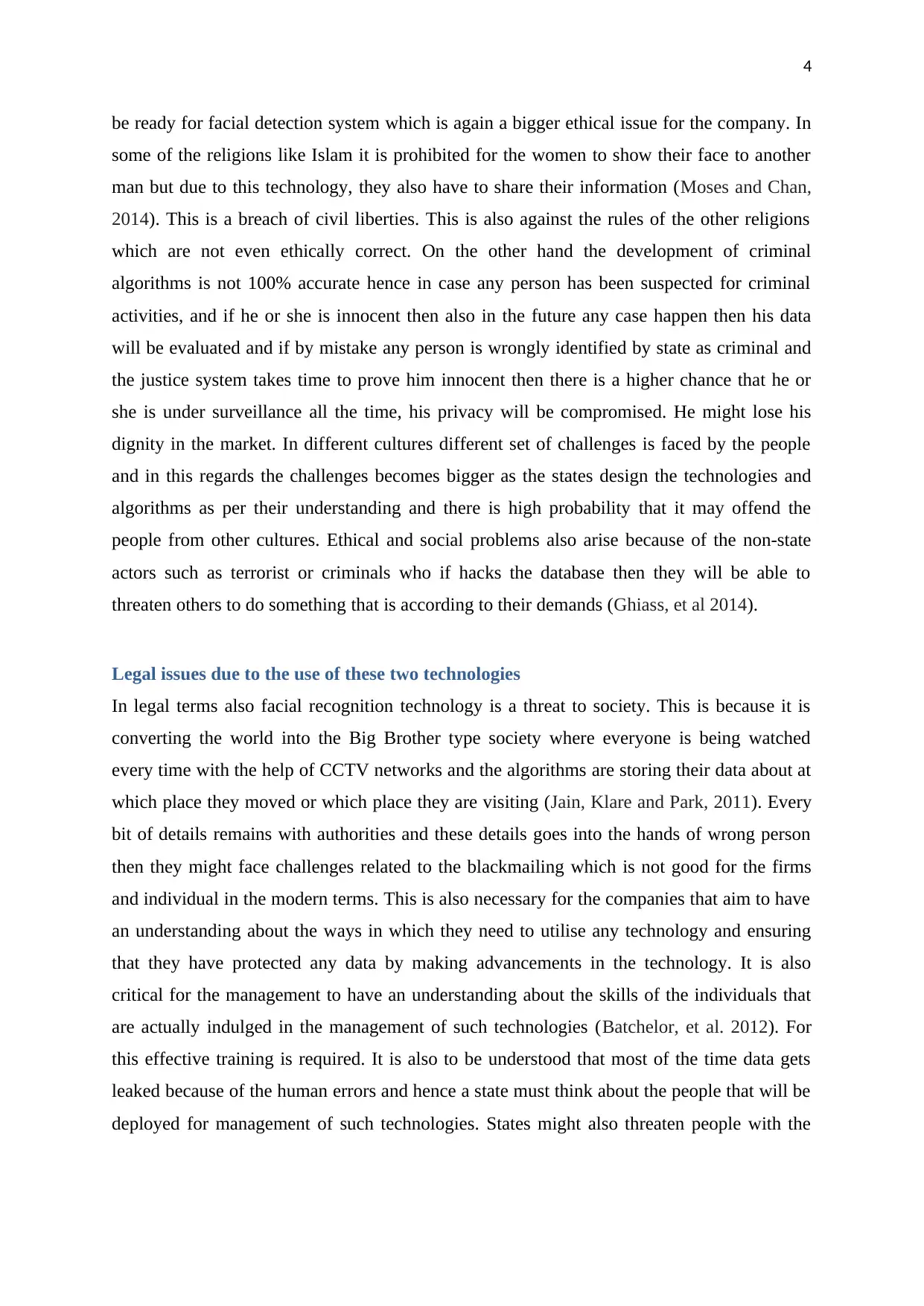
4
be ready for facial detection system which is again a bigger ethical issue for the company. In
some of the religions like Islam it is prohibited for the women to show their face to another
man but due to this technology, they also have to share their information (Moses and Chan,
2014). This is a breach of civil liberties. This is also against the rules of the other religions
which are not even ethically correct. On the other hand the development of criminal
algorithms is not 100% accurate hence in case any person has been suspected for criminal
activities, and if he or she is innocent then also in the future any case happen then his data
will be evaluated and if by mistake any person is wrongly identified by state as criminal and
the justice system takes time to prove him innocent then there is a higher chance that he or
she is under surveillance all the time, his privacy will be compromised. He might lose his
dignity in the market. In different cultures different set of challenges is faced by the people
and in this regards the challenges becomes bigger as the states design the technologies and
algorithms as per their understanding and there is high probability that it may offend the
people from other cultures. Ethical and social problems also arise because of the non-state
actors such as terrorist or criminals who if hacks the database then they will be able to
threaten others to do something that is according to their demands (Ghiass, et al 2014).
Legal issues due to the use of these two technologies
In legal terms also facial recognition technology is a threat to society. This is because it is
converting the world into the Big Brother type society where everyone is being watched
every time with the help of CCTV networks and the algorithms are storing their data about at
which place they moved or which place they are visiting (Jain, Klare and Park, 2011). Every
bit of details remains with authorities and these details goes into the hands of wrong person
then they might face challenges related to the blackmailing which is not good for the firms
and individual in the modern terms. This is also necessary for the companies that aim to have
an understanding about the ways in which they need to utilise any technology and ensuring
that they have protected any data by making advancements in the technology. It is also
critical for the management to have an understanding about the skills of the individuals that
are actually indulged in the management of such technologies (Batchelor, et al. 2012). For
this effective training is required. It is also to be understood that most of the time data gets
leaked because of the human errors and hence a state must think about the people that will be
deployed for management of such technologies. States might also threaten people with the
be ready for facial detection system which is again a bigger ethical issue for the company. In
some of the religions like Islam it is prohibited for the women to show their face to another
man but due to this technology, they also have to share their information (Moses and Chan,
2014). This is a breach of civil liberties. This is also against the rules of the other religions
which are not even ethically correct. On the other hand the development of criminal
algorithms is not 100% accurate hence in case any person has been suspected for criminal
activities, and if he or she is innocent then also in the future any case happen then his data
will be evaluated and if by mistake any person is wrongly identified by state as criminal and
the justice system takes time to prove him innocent then there is a higher chance that he or
she is under surveillance all the time, his privacy will be compromised. He might lose his
dignity in the market. In different cultures different set of challenges is faced by the people
and in this regards the challenges becomes bigger as the states design the technologies and
algorithms as per their understanding and there is high probability that it may offend the
people from other cultures. Ethical and social problems also arise because of the non-state
actors such as terrorist or criminals who if hacks the database then they will be able to
threaten others to do something that is according to their demands (Ghiass, et al 2014).
Legal issues due to the use of these two technologies
In legal terms also facial recognition technology is a threat to society. This is because it is
converting the world into the Big Brother type society where everyone is being watched
every time with the help of CCTV networks and the algorithms are storing their data about at
which place they moved or which place they are visiting (Jain, Klare and Park, 2011). Every
bit of details remains with authorities and these details goes into the hands of wrong person
then they might face challenges related to the blackmailing which is not good for the firms
and individual in the modern terms. This is also necessary for the companies that aim to have
an understanding about the ways in which they need to utilise any technology and ensuring
that they have protected any data by making advancements in the technology. It is also
critical for the management to have an understanding about the skills of the individuals that
are actually indulged in the management of such technologies (Batchelor, et al. 2012). For
this effective training is required. It is also to be understood that most of the time data gets
leaked because of the human errors and hence a state must think about the people that will be
deployed for management of such technologies. States might also threaten people with the
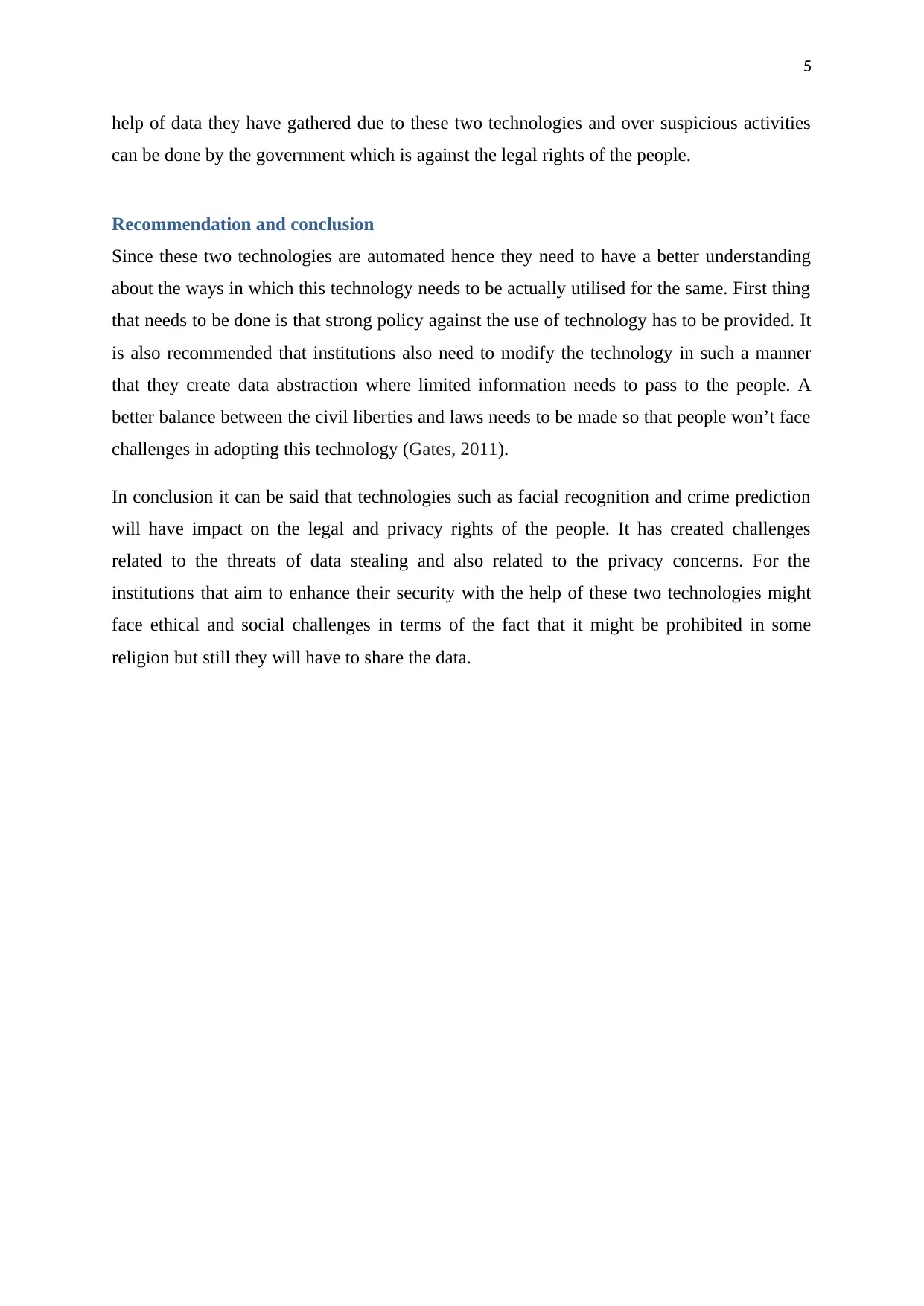
5
help of data they have gathered due to these two technologies and over suspicious activities
can be done by the government which is against the legal rights of the people.
Recommendation and conclusion
Since these two technologies are automated hence they need to have a better understanding
about the ways in which this technology needs to be actually utilised for the same. First thing
that needs to be done is that strong policy against the use of technology has to be provided. It
is also recommended that institutions also need to modify the technology in such a manner
that they create data abstraction where limited information needs to pass to the people. A
better balance between the civil liberties and laws needs to be made so that people won’t face
challenges in adopting this technology (Gates, 2011).
In conclusion it can be said that technologies such as facial recognition and crime prediction
will have impact on the legal and privacy rights of the people. It has created challenges
related to the threats of data stealing and also related to the privacy concerns. For the
institutions that aim to enhance their security with the help of these two technologies might
face ethical and social challenges in terms of the fact that it might be prohibited in some
religion but still they will have to share the data.
help of data they have gathered due to these two technologies and over suspicious activities
can be done by the government which is against the legal rights of the people.
Recommendation and conclusion
Since these two technologies are automated hence they need to have a better understanding
about the ways in which this technology needs to be actually utilised for the same. First thing
that needs to be done is that strong policy against the use of technology has to be provided. It
is also recommended that institutions also need to modify the technology in such a manner
that they create data abstraction where limited information needs to pass to the people. A
better balance between the civil liberties and laws needs to be made so that people won’t face
challenges in adopting this technology (Gates, 2011).
In conclusion it can be said that technologies such as facial recognition and crime prediction
will have impact on the legal and privacy rights of the people. It has created challenges
related to the threats of data stealing and also related to the privacy concerns. For the
institutions that aim to enhance their security with the help of these two technologies might
face ethical and social challenges in terms of the fact that it might be prohibited in some
religion but still they will have to share the data.
⊘ This is a preview!⊘
Do you want full access?
Subscribe today to unlock all pages.

Trusted by 1+ million students worldwide
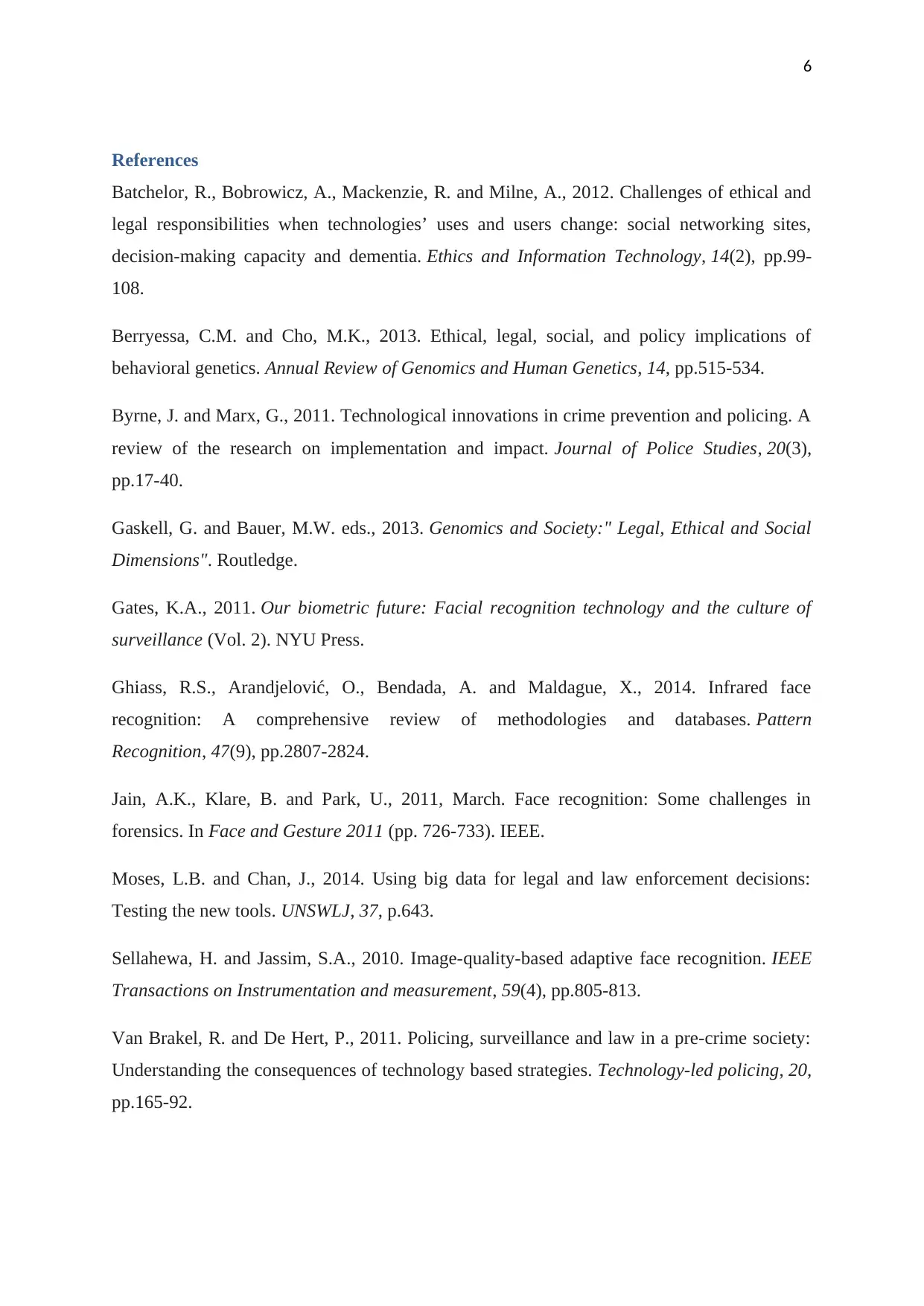
6
References
Batchelor, R., Bobrowicz, A., Mackenzie, R. and Milne, A., 2012. Challenges of ethical and
legal responsibilities when technologies’ uses and users change: social networking sites,
decision-making capacity and dementia. Ethics and Information Technology, 14(2), pp.99-
108.
Berryessa, C.M. and Cho, M.K., 2013. Ethical, legal, social, and policy implications of
behavioral genetics. Annual Review of Genomics and Human Genetics, 14, pp.515-534.
Byrne, J. and Marx, G., 2011. Technological innovations in crime prevention and policing. A
review of the research on implementation and impact. Journal of Police Studies, 20(3),
pp.17-40.
Gaskell, G. and Bauer, M.W. eds., 2013. Genomics and Society:" Legal, Ethical and Social
Dimensions". Routledge.
Gates, K.A., 2011. Our biometric future: Facial recognition technology and the culture of
surveillance (Vol. 2). NYU Press.
Ghiass, R.S., Arandjelović, O., Bendada, A. and Maldague, X., 2014. Infrared face
recognition: A comprehensive review of methodologies and databases. Pattern
Recognition, 47(9), pp.2807-2824.
Jain, A.K., Klare, B. and Park, U., 2011, March. Face recognition: Some challenges in
forensics. In Face and Gesture 2011 (pp. 726-733). IEEE.
Moses, L.B. and Chan, J., 2014. Using big data for legal and law enforcement decisions:
Testing the new tools. UNSWLJ, 37, p.643.
Sellahewa, H. and Jassim, S.A., 2010. Image-quality-based adaptive face recognition. IEEE
Transactions on Instrumentation and measurement, 59(4), pp.805-813.
Van Brakel, R. and De Hert, P., 2011. Policing, surveillance and law in a pre-crime society:
Understanding the consequences of technology based strategies. Technology-led policing, 20,
pp.165-92.
References
Batchelor, R., Bobrowicz, A., Mackenzie, R. and Milne, A., 2012. Challenges of ethical and
legal responsibilities when technologies’ uses and users change: social networking sites,
decision-making capacity and dementia. Ethics and Information Technology, 14(2), pp.99-
108.
Berryessa, C.M. and Cho, M.K., 2013. Ethical, legal, social, and policy implications of
behavioral genetics. Annual Review of Genomics and Human Genetics, 14, pp.515-534.
Byrne, J. and Marx, G., 2011. Technological innovations in crime prevention and policing. A
review of the research on implementation and impact. Journal of Police Studies, 20(3),
pp.17-40.
Gaskell, G. and Bauer, M.W. eds., 2013. Genomics and Society:" Legal, Ethical and Social
Dimensions". Routledge.
Gates, K.A., 2011. Our biometric future: Facial recognition technology and the culture of
surveillance (Vol. 2). NYU Press.
Ghiass, R.S., Arandjelović, O., Bendada, A. and Maldague, X., 2014. Infrared face
recognition: A comprehensive review of methodologies and databases. Pattern
Recognition, 47(9), pp.2807-2824.
Jain, A.K., Klare, B. and Park, U., 2011, March. Face recognition: Some challenges in
forensics. In Face and Gesture 2011 (pp. 726-733). IEEE.
Moses, L.B. and Chan, J., 2014. Using big data for legal and law enforcement decisions:
Testing the new tools. UNSWLJ, 37, p.643.
Sellahewa, H. and Jassim, S.A., 2010. Image-quality-based adaptive face recognition. IEEE
Transactions on Instrumentation and measurement, 59(4), pp.805-813.
Van Brakel, R. and De Hert, P., 2011. Policing, surveillance and law in a pre-crime society:
Understanding the consequences of technology based strategies. Technology-led policing, 20,
pp.165-92.
Paraphrase This Document
Need a fresh take? Get an instant paraphrase of this document with our AI Paraphraser

7
Wright, D., Finn, R., Gellert, R., Gutwirth, S., Schütz, P., Friedewald, M., Venier, S. and
Mordini, E., 2014. Ethical dilemma scenarios and emerging technologies. Technological
Forecasting and Social Change, 87, pp.325-336.
Wright, D., Finn, R., Gellert, R., Gutwirth, S., Schütz, P., Friedewald, M., Venier, S. and
Mordini, E., 2014. Ethical dilemma scenarios and emerging technologies. Technological
Forecasting and Social Change, 87, pp.325-336.
1 out of 8
Related Documents
Your All-in-One AI-Powered Toolkit for Academic Success.
+13062052269
info@desklib.com
Available 24*7 on WhatsApp / Email
![[object Object]](/_next/static/media/star-bottom.7253800d.svg)
Unlock your academic potential
Copyright © 2020–2025 A2Z Services. All Rights Reserved. Developed and managed by ZUCOL.





